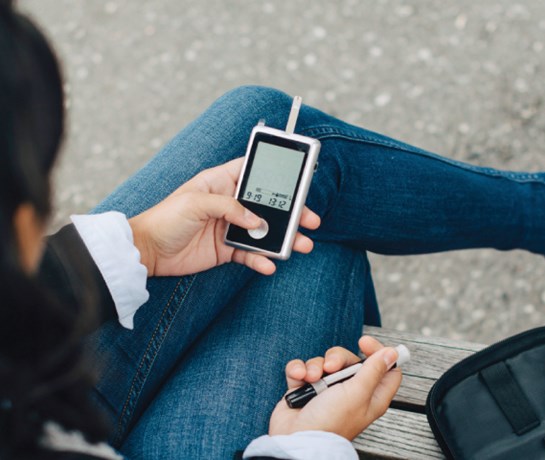

Can technology help you manage your condition?
Managing diabetes is a big responsibility. The condition can affect nearly every part of the body. If you live with diabetes, you know the steps you must take every day to keep your blood glucose (sugar) level under control. Maybe you’ve seen ads promoting the latest technology designed to help manage diabetes. There are many new diabetes management tools and devices to consider, from apps and smartwatches to continuous glucose monitors and insulin pumps. Which tools (if any) make sense for you?
What is diabetes?
When people eat, the pancreas releases a hormone called insulin that helps move glucose from the blood to the body’s cells. That glucose is used for energy. Usually the pancreas produces enough insulin to keep blood sugar levels steady. Diabetes occurs when the body stops using insulin the way it should or the pancreas is unable to produce enough insulin. This causes blood sugar levels to build, which increases the risk for many other health conditions.
Heard of prediabetes? It is a diagnosis that indicates blood sugar levels are higher than normal but not high enough to be at diabetic levels. Prediabetes can be reversed by adopting lifestyle changes, including eating a healthy diet.
People with diabetes have an increased risk of high blood pressure and cholesterol and tend to carry extra body weight. That makes careful monitoring of blood sugar levels an important task.
Health apps
There are a multitude of health apps available for smartphones. There are general wellness apps that can be configured to support the health goals of people with diabetes and prediabetes. Other apps are made specifically for those with diabetes and facilitate tracking glucose data, meals, snacks, and physical activity.
These apps rely on you to set macronutrient (protein, carbohydrates, and fats) values based on your target goals. A registered dietician or certified diabetes educator can help you establish these goals if you don’t know what yours should be. You must enter glucose readings, food intake, and activities, so careful tracking is required to get an accurate picture of how you are progressing. Some apps contain food databases that can simplify tracking meals as well as provide nutritional information. Health apps can be helpful tools for keeping you on your diabetic plan and providing motivation when you need it.
Smartwatches are also a great option These devices help you track your activity, the intensity of that activity, and how many calories you burned. They also record other health data, like your heart rate and sleep patterns. Some smartwatches can be paired with certain continuous glucose monitors (CGMs) to automatically record glucose readings.
Blood glucose monitoring
Speaking of CGMs, one of the first things a person with diabetes learns to do is measure their blood sugar. There are many choices, from a basic finger-prick or hand-held meter to more advanced devices. Test-strip glucose meters have come a long way. Many of them can be connected to a smartphone and tracked through an app.
The Food and Drug Administration (FDA) approved the first CGM system in 1999, and the technology has continued to improve ever since. CGMs are small, wearable devices that record glucose levels around the clock. They include a blood sugar sensor that is inserted under the skin. A transmitter fits onto the sensor and sends glucose readings to a display device or smartphone app. Some CGMs have an alarm that lets you know if your blood sugar gets too high or low. Some even send notifications to a smartphone app! CGMs have the potential to provide better glucose control since they provide up-to-the minute information and tracking. They can help you set goals, stick with healthy lifestyle habits, and determine the need for medication adjustments.
Your provider can help you choose the right monitoring system for your situation, but it helps to think about the options in advance so you can be prepared with questions. Here are some considerations:
- How often do you need to test?
- A finger-prick test once a day might feel manageable, but a CGM may be preferable if numerous readings are required each day. A CGM means fewer finger pricks but is more complex and involves inserting the sensor under the skin, which can sometimes cause skin irritation. Some CGM sensors can be worn for up to two weeks (depending upon the model) before being replaced.
- Do you prefer (or need) a simple device for basic information or a more advanced one that provides detailed data?
- Be sure that you select a meter that is easy to read and comfortable to use. For some, simpler is better. Tech-savvy people may like having access to the more in-depth information provided by a CGM.
- What does your insurance cover?
- Some insurers limit coverage to specific models. You can find out what is available to you by calling your insurer, or your provider’s office can ask on your behalf. You should also compare monthly costs for the options available to you.
Need insulin?
If you use insulin, an insulin pump will give you a break from frequent shots. Pumps attach directly to the skin, sometimes with additional tubing. They are programmed to release small doses of insulin continuously (basal) or as a larger dose (bolus) at mealtimes to control spikes in blood sugar after eating. Use of a pump often results in improved blood sugar levels.
Pumps can make planning meals and activities easier. They can be beneficial for people who often have low blood sugar reactions or absorb food slowly. Pumps also work well for people with active lifestyles and for women who are planning to become pregnant.
Using an insulin pump has a learning curve; learning how to set it up, insert it, and use it may require training. When using an insulin pump, it’s still important to check your blood sugar levels regularly to make sure you are getting the proper amount of insulin.
If you and your provider agree that a pump is a good option for you, be sure to ask your health plan about coverage. Pumps can be expensive, so you’ll want to know if your insurer covers them in advance.
KnovaSolutions can help
Managing diabetes can be a challenge. If you need help untangling the web of medical information, medications, and technology options, please reach out to KnovaSolutions®. We are here to answer questions, help you prepare for provider visits, discuss pros and cons, and offer general support. Let us know how we can help! Call us at 800-355-0885 Monday through Friday from 8 a.m. to 8 p.m. MST.





